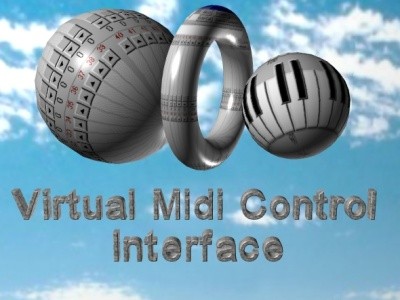VMCI 1.22
 |
General
How to install VMCI
Download area
General
VMCI (Virtual Midi Control Interface) is a freeware/donationware GUI program
which allows the user to send most MIDI data to a MIDI device by means of
gestural actions on the computer keyboard and mouse. VMCI is fully
configurable and can give the user a total control of MIDI messages, even
without any MIDI interface card and any external MIDI keyboard or controller.
This program is primarily thinked to be used to control real-time versions
of Csound, but it can also be used with any internal or external midi device
or computer programs such as sequencers.
There are two VMCI modes:
-
LITE mode (completely free)
-
PRO mode (this mode can be enabled only by means of a magic code granted
to the persons who send a donation of any entity to the author)
The features of the two modes are identical, only the number of controller
available is different.
VMCI requirements:
-
Windows 95/98/ME or NT/2000/XP.
-
800x600 monitor resolution or higher.
-
Csound is optional, you can use VMCI also together with other programs such
as sequencers etc., but the best VMCI job is reached when it is used together
with Csound itself.
-
A virtual midi Loopback device such as HUBI'S Midi Loopback (it is optional
if you don't intend to control only hardware MIDI instruments, but required
when using Csound or sequencers)
-
A fast computer if an instance of Csound is used at the same time in real-time
(Pentium II processor recommended).
VMCI features:
-
Four panels of completely configurable 7-bit control sliders
(one panel in Lite mode). Each panel contains 64 sliders; the total is 256
sliders available (8 in Lite mode).
-
Two panels of completely configurable 14-bit control sliders
(one in Lite mode). Each panel contains 32 sliders; the total is 64 sliders
(2 in Lite mode).
-
Two panels (one in Lite mode) of mouse-sensitive areas. Each
panel contains 8 areas; the total is 16 areas (2 areas in Lite mode). Each
area can be clicked by the mouse to send two control messages a time. These
areas are similar to the 'xyin' opcode of Csound.
-
A virtual MIDI keyboard can send midi data by a mouse
click on one of the 192 piano-key-like buttons, or by pressing a key of the
alphanumeric keyboard. Each key is completely configurable to send any
midi-message of any midi-channel. Up to 959 events can be stored (24 events
in Lite mode).
-
The configuration, including all slider positions and all parameters customized
by the user, can be saved to a file and restored when needed (both
in Lite and Pro modes).
How to install VMCI
To install VMCI you must do the following steps:
-
You must download the three zipped archives: The executable, the manual in
html format and the VisualBasic5 runtime files (Tip: If any program
written in VisualBasic5 is already installed on your computer, maybe you
don't have to download and install the runtime files. So download
only the executable and try to run it. Then, only if something goes wrong,
that is some missing file error messages appear, let's download and install
the runtime files.)
-
Create a directory of your choice and decompress the runtime archive in it,
as well as the executable archive and the manual archive.
-
Create a shortcut of the executable and the HTML manual, and put them on
the desktop or in the start menu.
-
Download and install Hubi's Loopback virtual MIDI device.
-
Start VMCI by double clicking its icon.




VMCI DOWNLOAD AREA
 gabriel@musicaverticale.net
gabriel@musicaverticale.net
 VMCI 1.22 executable by Gabriel Maldonado (155
KB)
VMCI 1.22 executable by Gabriel Maldonado (155
KB)
 VMCI 1.22 executable by
Gabriel Maldonado (155 KB) (SUNSITE - Vienna University FTP site)
VMCI 1.22 executable by
Gabriel Maldonado (155 KB) (SUNSITE - Vienna University FTP site)
 VMCI manual in HTML format (252 KB)
VMCI manual in HTML format (252 KB)
VMCI
manual in HTML format (252 KB) (SUNSITE - Vienna University FTP site)
 VisualBasic5 runtime files not needed if any
program written in VisualBasic5 is already installed on your computer.
VisualBasic5 runtime files not needed if any
program written in VisualBasic5 is already installed on your computer.
VisualBasic5
runtime files (1'435 KB) (SUNSITE - Vienna University FTP site) not
needed if any program written in VisualBasic5 is already installed
on your computer.
MIDI UTILITIES to use together with VMCI
A virtual MIDI device is needed in order to use VMCI together with Csound.
I suggest Hubi's Loopback.
 Hubi's Loopback
Hubi's Loopback
Also I recommend you to download MIDI-OX, a very useful midi monitor
to view the midi message flow:
 Midi-ox
Midi-ox






![]()
 VMCI 1.22 executable by Gabriel Maldonado (155
KB)
VMCI 1.22 executable by Gabriel Maldonado (155
KB)
 VMCI 1.22 executable by
Gabriel Maldonado (155 KB) (SUNSITE - Vienna University FTP site)
VMCI 1.22 executable by
Gabriel Maldonado (155 KB) (SUNSITE - Vienna University FTP site)
![]() VMCI manual in HTML format (252 KB)
VMCI manual in HTML format (252 KB)
 VisualBasic5 runtime files not needed if any
program written in VisualBasic5 is already installed on your computer.
VisualBasic5 runtime files not needed if any
program written in VisualBasic5 is already installed on your computer.
![]()
![]()
![]()
![]()